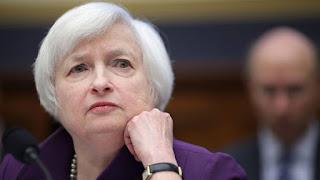The (perhaps perverse) logic goes something like this: since the Fed is raising interest rates, the economy
must be gaining momentum. Never mind that virtually every analyst is
simultaneously downgrading the prospects for fourth-quarter growth to an
average of about 2 per cent (in real terms), which has been the pattern
in virtually every quarter since the third round of quantitative easing was introduced.
Indeed, it is possible to argue that the Fed may well reverse its first hike, rather than continue on the path of small, upward adjustments in the cost of short-term money. That is because there are lots of macro and micro data points to suggest that the economic healing is still far from complete.
A falling unemployment rate and a 211,000 increase in payrolls in November is one of the principal reasons the Fed is widely expected to shift borrowing costs up from near zero.
But one of the main causes of that falling jobless rate is hardly a
cause for optimism about economic prospects. In several studies over the
past few months, JPMorgan economists have concluded that one of the
main reasons both for overly optimistic forecasts on global economic
growth (that inevitably have to be marked down) and for lower than
expected joblessness is because of falling productivity. More workers
need to be hired because the output of each worker has dropped — not
because the economy is so vibrant. It is not clear what the causes are,
but the consequences are deeply disturbing.“The confirmed disappointment in productivity growth sends a stark warning that underlying rates of potential real GDP growth may need to be reassessed,” said JPMorgan economists last week.
Their finding could well complicate the debate within the Fed over policy in the coming months.
Because lower productivity constitutes a key part of the sharp fall in labour slack, inflation may well move higher as employers are forced to offer bigger pay checks for workers whose skills and output become ever more marginal.
The debate over the future path of Fed tightening comes as a key market barometer is flashing red. The US high-yield, or junk bond market, is, as Goldman Sachs notes, already emitting recessionary signals as borrowing costs for speculative rated companies climbs sharply above Treasury yields.
While the bank downplays this signal, a wider risk premium for owning junk debt, is not surprising when many sectors are registering negative revenue growth. Moreover, distress is not just confined to energy-related companies, as industrial and chemical companies have come under pressure from the bond market.
In a sign of investor aversion, lower-rated triple C debt issuers so far this year have accounted for just 12 per cent of total debt sales, only the second time in the last decade — since 2009 — says Goldman, that this poorly-rated group accounted for such a small fraction of the total.
With the prospect of Fed interest rate increases making the burden of debt more onerous, while operating performance comes under pressure, surely investors are right to gravitate to higher-quality issuers.
The Fed’s quantitative easing was never about directly mending the real economy, it was always about supporting asset prices and the banks. But that “victory” in getting asset prices up was always provisional. With the earnings of S&P 500 companies dropping 2 per cent in the third quarter and the credit markets increasingly jittery, financial markets may well weaken as the appetite for risk assets diminishes.
Perhaps then it is best to only be selectively jolly this holiday season.

No comments:
Post a Comment